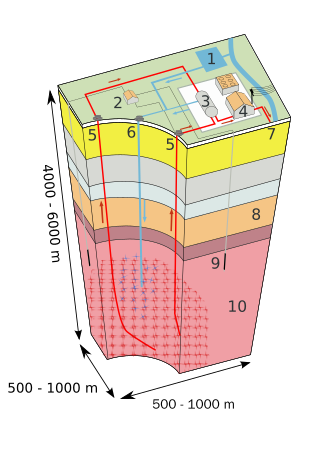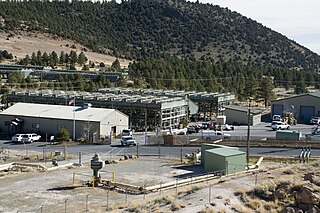
Geothermal energy is thermal energy extracted from the Earth's crust. It combines energy from the formation of the planet and from radioactive decay. Geothermal energy has been exploited as a source of heat and/or electric power for millennia.

A spring is a natural exit point at which groundwater emerges from an aquifer and flows across the ground surface as surface water. It is a component of the hydrosphere, as well as a part of the water cycle. Springs have long been important for humans as a source of fresh water, especially in arid regions which have relatively little annual rainfall.

The potential for exploiting geothermal energy in the United Kingdom on a commercial basis was initially examined by the Department of Energy in the wake of the 1973 oil crisis. Several regions of the country were identified, but interest in developing them was lost as petroleum prices fell. Although the UK is not actively volcanic, a large heat resource is potentially available via shallow geothermal ground source heat pumps, shallow aquifers and deep saline aquifers in the mesozoic basins of the UK. Geothermal energy is plentiful beneath the UK, although it is not readily accessible currently except in specific locations.

Geothermal energy in the United States was first used for electric power production in 1960. The Geysers in Sonoma and Lake counties, California was developed into what is now the largest geothermal steam electrical plant in the world, at 1,517 megawatts. Other geothermal steam fields are known in the western United States and Alaska. Geothermally generated electric power can be dispatchable to follow the demands of changing loads. Environmental impact of this energy source includes hydrogen sulfide emissions, corrosive or saline chemicals discharged in waste water, possible seismic effects from water injection into rock formations, waste heat and noise.

The Geysers is the world's largest geothermal field, containing a complex of 18 geothermal power plants, drawing steam from more than 350 wells, located in the Mayacamas Mountains approximately 72 miles (116 km) north of San Francisco, California.

An enhanced geothermal system (EGS) generates geothermal electricity without natural convective hydrothermal resources. Traditionally, geothermal power systems operated only where naturally occurring heat, water, and rock permeability are sufficient to allow energy extraction. However, most geothermal energy within reach of conventional techniques is in dry and impermeable rock. EGS technologies expand the availability of geothermal resources through stimulation methods, such as 'hydraulic stimulation'.
Geothermal energy is the second most used form of renewable energy in Russia but represents less than 1% of the total energy production. The first geothermal power plant in Russia, which was the first Binary cycle power station in the world, was built at Pauzhetka, Kamchatka, in 1966, with a capacity of 5 MW. The total geothermal installed capacity is 81.9 MW, with 50 MW coming from a plant at Verkhne-Mutnovsky.Two other plants were built on the Kamchatka Peninsula in 1999 and 2002. Two smaller additional plants were installed on the islands of Kunashir and Iturup in 2007. Most geothermal resources are currently used for heating settlements in the North Caucasus and Kamchatka. Half of the geothermal production is used to heat homes and industrial buildings, one third is used to heat greenhouses and 13% is used for industrial processes.

Svartsengi power station is a geothermal power plant, which is located in the Svartsengi geothermal field, about 4 kilometres (2.5 mi) north of Grindavík, approximately 20 km (12 mi) SE of Keflavík International Airport and 45 km (28 mi) from Reykjavík. The electric power station was built in 1976 by HS Orka. It was the world's first combined geothermal power plant for electric power generation and hot water production for district heating.
United Downs Deep Geothermal Power is the United Kingdom's first geothermal electricity project. It is situated near Redruth in Cornwall, England. It is owned and operated by Geothermal Engineering (GEL), a private UK company. The drilling site is on the United Downs industrial estate, chosen for its geology, existing grid connection, proximity to access roads and limited impact on local communities. Energy is extracted by cycling water through a naturally hot reservoir and using the heated water to drive a turbine to produce electricity and for direct heating. The company plans to begin delivering electricity and heat in 2024. A lithium resource was discovered in the well.

Ormat Technologies, Inc. is an international company based in Reno, Nevada, United States. Ormat supplies alternative and renewable geothermal energy technology. The company has built over 190 power plants and installed over 3,200 MW. As of January 2021 it owns and operates 933 MW of geothermal and recovered energy based power plants. Ormat has supplied over 1000 turbochargers worldwide: North America, South America, Europe, Australia, and Asia. The company's products also include turbines, generators, and heat exchangers.

The Olkaria Area is a region located immediately to the south of Lake Naivasha in the Great Rift Valley of Kenya, Africa. It is geothermally active and is being used to generate clean electric power. The region has an estimated potential of 2,000 MW. This is almost double the maximum daily electricity peak demand recorded in 2008/2009 for the entire country.
The Gümüşköy Geothermal Power Plant is an air-cooled Organic Ranking Cycle (ORC) system geothermal power plant located at Gümüşköy village of Germencik district in Aydın Province, Turkey. The power plant feeds from the 182 °C Gümüşköy Geothermal Reservoir, which was discovered with the GK-1 geothermal well in October 2008.

Brine mining is the extraction of useful materials which are naturally dissolved in brine. The brine may be seawater, other surface water, groundwater, or hyper-saline solutions from several industries. It differs from solution mining or in-situ leaching in that those methods inject water or chemicals to dissolve materials which are in a solid state; in brine mining, the materials are already dissolved.

The Puna Geothermal Venture (PGV) is a geothermal energy power plant on the island of Hawaii, the largest island in the state of Hawaii. The plant was shut down shortly after the start of the May 2018 lower Puna eruption, and resumed power generation in November 2020. The eruption had caused lava to flow over a PGV power substation, a warehouse and at least three geothermal wells that had been preventatively quenched and capped when lava fountains erupted nearby, eventually also cutting off road access.

Solar augmented geothermal energy (SAGE) is an advanced method of geothermal energy that creates a synthetic geothermal storage resource by heating a natural brine with solar energy and adding enough heat when the sun shines to generate power 24 hours a day. The earth is given enough energy in one hour to provide all electrical needs for a year. Available energy is not the issue, but energy storage is the problem and SAGE creates effective storage and electrical power delivery on demand. This technology is especially effective for geothermal wells that have demonstrated inconsistent heat or idle oil or gas fields that have demonstrated the proper geology and have an abundance of solar.

The Mammoth Geothermal Complex is a complex of 4 geothermal power stations located at Casa Diablo Hot Springs about 3 miles (4.8 km) east of Mammoth Lakes, California. The complex is owned by Ormat and operated by its subsidiary Mammoth Pacific.
Jersey Valley is a valley in the U.S. state of Nevada.
Frontier Observatory for Research in Geothermal Energy (FORGE) is a US government program supporting research into geothermal energy. The FORGE site is near Milford, Utah, funded for up to $140 million. As of 2023, numerous test wells had been drilled, and flux measurements had been conducted, but energy production had not commenced.













